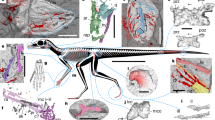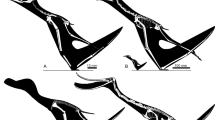Abstract
The long-term accumulation of biodiversity has been punctuated by remarkable evolutionary transitions that allowed organisms to exploit new ecological opportunities. Mesozoic flying reptiles (the pterosaurs), which dominated the skies for more than 150 million years, were the product of one such transition. The ancestors of pterosaurs were small and probably bipedal early archosaurs1, which were certainly well-adapted to terrestrial locomotion. Pterosaurs diverged from dinosaur ancestors in the Early Triassic epoch (around 245 million years ago); however, the first fossils of pterosaurs are dated to 25 million years later, in the Late Triassic epoch. Therefore, in the absence of proto-pterosaur fossils, it is difficult to study how flight first evolved in this group. Here we describe the evolutionary dynamics of the adaptation of pterosaurs to a new method of locomotion. The earliest known pterosaurs took flight and subsequently appear to have become capable and efficient flyers. However, it seems clear that transitioning between forms of locomotion2,3—from terrestrial to volant—challenged early pterosaurs by imposing a high energetic burden, thus requiring flight to provide some offsetting fitness benefits. Using phylogenetic statistical methods and biophysical models combined with information from the fossil record, we detect an evolutionary signal of natural selection that acted to increase flight efficiency over millions of years. Our results show that there was still considerable room for improvement in terms of efficiency after the appearance of flight. However, in the Azhdarchoidea4, a clade that exhibits gigantism, we test the hypothesis that there was a decreased reliance on flight5,6,7 and find evidence for reduced selection on flight efficiency in this clade. Our approach offers a blueprint to objectively study functional and energetic changes through geological time at a more nuanced level than has previously been possible.
This is a preview of subscription content, access via your institution
Access options
Access Nature and 54 other Nature Portfolio journals
Get Nature+, our best-value online-access subscription
$29.99 / 30 days
cancel any time
Subscribe to this journal
Receive 51 print issues and online access
$199.00 per year
only $3.90 per issue
Buy this article
- Purchase on Springer Link
- Instant access to full article PDF
Prices may be subject to local taxes which are calculated during checkout



Similar content being viewed by others
Data availability
The phylogeny that we generated in this study (Fig. 2a) is included as Supplementary Information (Supplementary Data 1) with this Article. No other data were generated or analysed during the current study. All data used are available from published sources and are cited in the text as appropriate.
Code availability
All analyses in this study were conducted using readily available, published programs and are cited in the text. Version numbers of the programs we used are as follows: Tracer v.1.7 (2018), MATLAB v.9.2 (2017), R v.3.4.4 (2017), BEAST 2 (2014) and BayesTraits v.3 (2018).
References
Andres, B., Clark, J. & Xu, X. The earliest pterodactyloid and the origin of the group. Curr. Biol. 24, 1011–1016 (2014).
Williams, T. M. The evolution of cost efficient swimming in marine mammals: limits to energetic optimization. Phil. Trans. R. Soc. B 354, 193–201 (1999).
Alexander, R. M. One price to run, swim or fly? Nature 397, 651–653 (1999).
Naish, D. & Witton, M. P. Neck biomechanics indicate that giant Transylvanian azhdarchid pterosaurs were short-necked arch predators. PeerJ 5, e2908 (2017).
Hwang, K.-G., Huh, M., Lockley, M. G., Unwin, D. M. & Wright, J. L. New pterosaur tracks (Pteraichnidae) from the Late Cretaceous Uhangri formation, southwestern Korea. Geol. Mag. 139, 421–435 (2002).
Witton, M. P. & Naish, D. Azhdarchid pterosaurs: water-trawling pelican mimics or “terrestrial stalkers”? Acta Palaeontol. Pol. 60, 651–660 (2013).
Witton, M. P. & Naish, D. A reappraisal of azhdarchid pterosaur functional morphology and paleoecology. PLoS ONE 3, e2271 (2008).
Humphries, S., Bonser, R. H., Witton, M. P. & Martill, D. M. Did pterosaurs feed by skimming? Physical modelling and anatomical evaluation of an unusual feeding method. PLoS Biol. 5, e204 (2007).
Pennycuick, C. J. Modelling the Flying Bird Vol. 5 (Elsevier, 2008).
Taylor, G. & Thomas, A. Evolutionary Biomechanics: Selection, Phylogeny, and Constraint (Oxford Univ. Press, 2014).
Witton, M. P. A new approach to determining pterosaur body mass and its implications for pterosaur flight. Zitteliana 28, 143–158 (2008).
Henderson, D. M. Pterosaur body mass estimates from three-dimensional mathematical slicing. J. Vertebr. Paleontol. 30, 768–785 (2010).
Benson, R. B. J., Frigot, R. A., Goswami, A., Andres, B. & Butler, R. J. Competition and constraint drove Cope’s rule in the evolution of giant flying reptiles. Nat. Commun. 5, 3567 (2014).
Witton, M. P. Pterosaurs: Natural History, Evolution, Anatomy (Princeton Univ. Press, 2013).
Longrich, N. R., Martill, D. M. & Andres, B. Late Maastrichtian pterosaurs from North Africa and mass extinction of Pterosauria at the Cretaceous-Paleogene boundary. PLoS Biol. 16, e2001663 (2018).
Andres, B. & Myers, T. S. Lone star pterosaurs. Earth Environ. Sci. Trans. R. Soc. Edinb. 103, 383–398 (2012).
Organ, C. L., Shedlock, A. M., Meade, A., Pagel, M. & Edwards, S. V. Origin of avian genome size and structure in non-avian dinosaurs. Nature 446, 180–184 (2007).
Bale, R., Hao, M., Bhalla, A. P. S. & Patankar, N. A. Energy efficiency and allometry of movement of swimming and flying animals. Proc. Natl Acad. Sci. USA 111, 7517–7521 (2014).
Alexander, R. M. Models and the scaling of energy costs for locomotion. J. Exp. Biol. 208, 1645–1652 (2005).
Unwin, D. M. The Pterosaurs from Deep Time (Pi, 2005).
Averianov, A. Reconstruction of the neck of Azhdarcho lancicollis and lifestyle of azhdarchids (Pterosauria, Azhdarchidae). Paleontol. J. 47, 203–209 (2013).
Bestwick, J., Unwin, D. M., Butler, R. J., Henderson, D. M. & Purnell, M. A. Pterosaur dietary hypotheses: a review of ideas and approaches. Biol. Rev. Camb. Philos. Soc. 93, 2021–2048 (2018).
Schliep, K. P. phangorn: phylogenetic analysis in R. Bioinformatics 27, 592–593 (2011).
Stadler, T. Sampling-through-time in birth-death trees. J. Theor. Biol. 267, 396–404 (2010).
Stadler, T., Kühnert, D., Bonhoeffer, S. & Drummond, A. J. Birth–death skyline plot reveals temporal changes of epidemic spread in HIV and hepatitis C virus (HCV). Proc. Natl Acad. Sci. USA 110, 228–233 (2013).
Bouckaert, R. et al. BEAST 2: a software platform for Bayesian evolutionary analysis. PLOS Comput. Biol. 10, e1003537 (2014).
Drummond, A. J., Ho, S. Y. W., Phillips, M. J. & Rambaut, A. Relaxed phylogenetics and dating with confidence. PLoS Biol. 4, e88 (2006).
Lewis, P. O. A likelihood approach to estimating phylogeny from discrete morphological character data. Syst. Biol. 50, 913–925 (2001).
Yang, Z. Maximum likelihood phylogenetic estimation from DNA sequences with variable rates over sites: approximate methods. J. Mol. Evol. 39, 306–314 (1994).
Rambaut, A., Drummond, A. J., Xie, D., Baele, G. & Suchard, M. A. Posterior summarization in Bayesian phylogenetics using Tracer 1.7. Syst. Biol. 67, 901–904 (2018).
R Core Team. R: A Language and Environment for Statistical Computing. http://www.R-project.org/ (R Foundation for Statistical Computing, 2016).
Ward, C. V. Interpreting the posture and locomotion of Australopithecus afarensis: where do we stand? Am. J. Phys. Anthropol. 119, 185–215 (2002).
Pennycuick, C. J. Bird Flight Performance (Oxford Univ. Press, 1989).
Clarke, A. Dinosaur energetics: setting the bounds on feasible physiologies and ecologies. Am. Nat. 182, 283–297 (2013).
Pontzer, H., Allen, V. & Hutchinson, J. R. Biomechanics of running indicates endothermy in bipedal dinosaurs. PLoS ONE 4, e7783 (2009).
Pagel, M. Inferring evolutionary processes from phylogenies. Zool. Scr. 26, 331–348 (1997).
Freckleton, R. P., Harvey, P. H. & Pagel, M. Phylogenetic analysis and comparative data: a test and review of evidence. Am. Nat. 160, 712–726 (2002).
Acknowledgements
We thank C. O’Donovan, M. Pagel, G. Ruxton and M. Sakamoto for discussions during the course of this study. J.B. was funded by the Leverhulme Trust (ECF-2017-22). C.V. was funded by a Leverhulme Trust Research Project Grant (RPG-2017-071). M.J.B. was funded by a Natural Environment Research Council (NERC) UK (grant NE/P013724/1) and European Research Council (ERC) Advanced Grant (number 788203).
Author information
Authors and Affiliations
Contributions
C.V. and S.H. conceived the study. C.V., J.B., M.J.B. and S.H. collected the data. C.V., J.B., A.M. and S.H. conducted the phylogenetic and biophysical analyses. C.V., J.B., A.M., M.J.B. and S.H. interpreted the results and wrote the paper.
Corresponding authors
Ethics declarations
Competing interests
The authors declare no competing interests.
Additional information
Peer review information Nature thanks Adrian Thomas and the other, anonymous, reviewer(s) for their contribution to the peer review of this work.
Publisher’s note Springer Nature remains neutral with regard to jurisdictional claims in published maps and institutional affiliations.
Extended data figures and tables
Extended Data Fig. 1 Results of our n − 1 jack-knife procedure for the mass and wing area.
a, b, We compared the imputed values for each species from our phylogenetic imputation procedure with the published values for mass (a) and wing area (b), for studies in which that species had been excluded from the published value. Each point represents an individual species.
Extended Data Fig. 2 Comparison of flight performance metrics between pterosaurs and extant bats and birds.
a, We show the relationship between flight efficiency and mass in pterosaurs (Fig. 2b), with our mean phylogenetic imputations plotted with standard deviations shown as green ellipses. We superimpose a previously reported relationship between flight efficiency and mass for extant birds (orange line), as well as data points for six bat species (blue crosses). b, The relationship between sinking rate and mass for pterosaurs (Fig. 2c), with our mean phylogenetic imputations plotted with standard deviations shown by the blue ellipses. Superimposed, we show the range of the relationship between sinking rate and mass for Procellariiformes (orange box) and Accipitriformes7 (pink box) and individual data points for six specimens of an extinct Cretaceous bird (Sapeornis chaoyangensis) (orange circles with crosses), eleven extant bird species (orange crosses) and seven bat species (blue crosses). Triangles indicate pterosaur species for which we have published data on mass, wing area and wingspan. Circles indicate species for which we have only wingspan data. All azhdarchoids are coloured in red.
Supplementary information
Supplementary Information
This file contains Supplementary Text; Supplementary Table 1: Parameters for the flight model; and Supplementary Table 2: Species included in analyses (grey shading).
Supplementary Data 1
Posterior distribution of trees for pterosaurs produced from our phylogenetic inference model. File is provided in nexus format.
Rights and permissions
About this article
Cite this article
Venditti, C., Baker, J., Benton, M.J. et al. 150 million years of sustained increase in pterosaur flight efficiency. Nature 587, 83–86 (2020). https://doi.org/10.1038/s41586-020-2858-8
Received:
Accepted:
Published:
Issue Date:
DOI: https://doi.org/10.1038/s41586-020-2858-8
Comments
By submitting a comment you agree to abide by our Terms and Community Guidelines. If you find something abusive or that does not comply with our terms or guidelines please flag it as inappropriate.



